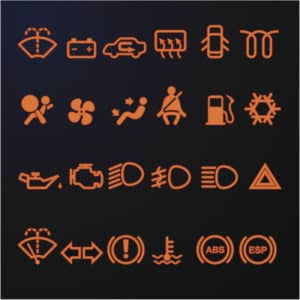What The Dashboard Warning Lights In Your Car Mean
 No matter the year, make, or model of your vehicle, dashboard lights are one of its essential components. They inform you whether the systems they’re tied to are working correctly or not.
No matter the year, make, or model of your vehicle, dashboard lights are one of its essential components. They inform you whether the systems they’re tied to are working correctly or not.
Understanding what the dashboard warning lights in your car mean is necessary to ensure a proper driving experience. These lights provide the most fail-proof way of knowing when something inside the vehicle isn’t working properly and are often your first indication of issues with your vehicle.
While the signs these lights show are mostly the same regardless of the vehicle, their precise locations may vary. Depending on the various colors they display (red, amber, green, and blue), you’ll be able to tell just how serious the warning they’re portraying is.
Your owner’s manual may be able to tell you what each light means, but we’re also a great resource! We encourage you to read through our handy guide of common check engine lights below.
Check Engine Light:
Usually, this light will turn on when the ignition is switched on and go away shortly after the engine is started and running. If it happens to stay on, then you should definitely pay attention to it as it could signal a serious problem with the engine. If you’re driving and see it flashing, slow down, stop, wait, and restart your vehicle to restart the system. While it could still be safe to drive, make sure to take your vehicle to a garage as soon as possible to avoid further trouble. A flashing check engine light usually means there is a problem that needs immediate attention by a professional mechanic with proper diagnostic tools.
Oil Pressure Light
When it comes to dashboard warning lights, the oil pressure light is one of the most serious to pay attention to. If you see it pop up, it could be a sign that your oil levels is low and needs to be topped off. However, if you check your oil and it’s fine, but the light remains lit up, avoid restarting the engine and call assistance immediately. This light is often a sign of something more serious brewing underneath the hood. If you top off the oil and the light goes off you should still make an appointment to find out why the light is on, you may be losing oil and it has not become visible under the car yet.
Brake System Light
Most of the time, when the brake system light remains on, it’s to signal that your handbrake needs to be fully released. However, if that’s not the case, be sure to pull over immediately and call for assistance. Chances are your brake fluid is too low or there’s a faulty brake pad wear sensor, but it could also be a much more serious issue in need of immediate check-up by a professional.
Battery Charge Light
The battery charge light should only illuminate when the ignition is on and the engine is off. However, if you’ve noticed it doesn’t light up or, to the contrary, it remains on when the engine is running, it could mean your battery isn’t charging correctly, meaning it will either need replacement or there’s something going on with the car’s wiring, alternator, or drive belt. Whatever the case may be, seek assistance immediately because, without the battery providing electricity to the vehicle, your headlights, power steering, and even the engine could begin to experience failure.
Temperature Warning Light
When the temperature warning light is on, this means your car is overheating or that it doesn’t have enough antifreeze/coolant. This might be due to improper maintenance or to a leaking, clogged, or broken radiator. Whatever the reason, make sure to stop the car and call assistance immediately so that a professional can come to check your vehicle out before you find yourself in a cloud of steam.
ABS Warning Light
The ABS warning light means there’s a problem with your Automatic Braking System, so you’ll need to immediately reduce speed and pull over. If this occurs you may still have standard brakes, but the ABS will not activate. However, not all cars have an ABS, so you may not even see this one as part of your dashboard warning lights.
Tire Pressure Sensor Warning
The tire pressure sensor monitors the amount of air inside the vehicle’s tires. If the air pressure is too low, it could affect your braking or even cause a blow-out when driving at high-speeds. Thus, if this dashboard warning light pops up, you should stop as soon as possible and inflate your tires back to the ideal pressure amount.
Traction Control Warning
If you’re seeing this sign light up amongst your dashboard warning lights, it means your wheels have lost their grip and you’re not getting enough help from the system to control traction, something that usually happens when driving in rain or snow. If the light is constantly on, it means your system has been deactivated, so check the owner’s manual to see how to get it back on. Many times, it takes a professional shop to reset this light that must be performed with special computerized tools.
Glow Plug Warning Light (Diesel-Only Vehicles)
This dashboard warning light is only to be found on diesel running vehicles. When it comes on, it means that the engine’s glow plugs are getting warmed up and you should not start your engine until it goes out. If you see it flashing, it indicates that there is a problem – which could be a worn-out glow plug – meaning you should call for assistance as soon as possible.

Leave a Reply
You must be logged in to post a comment.